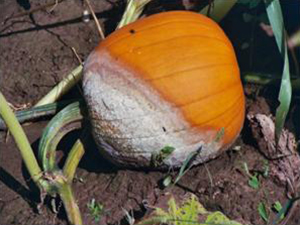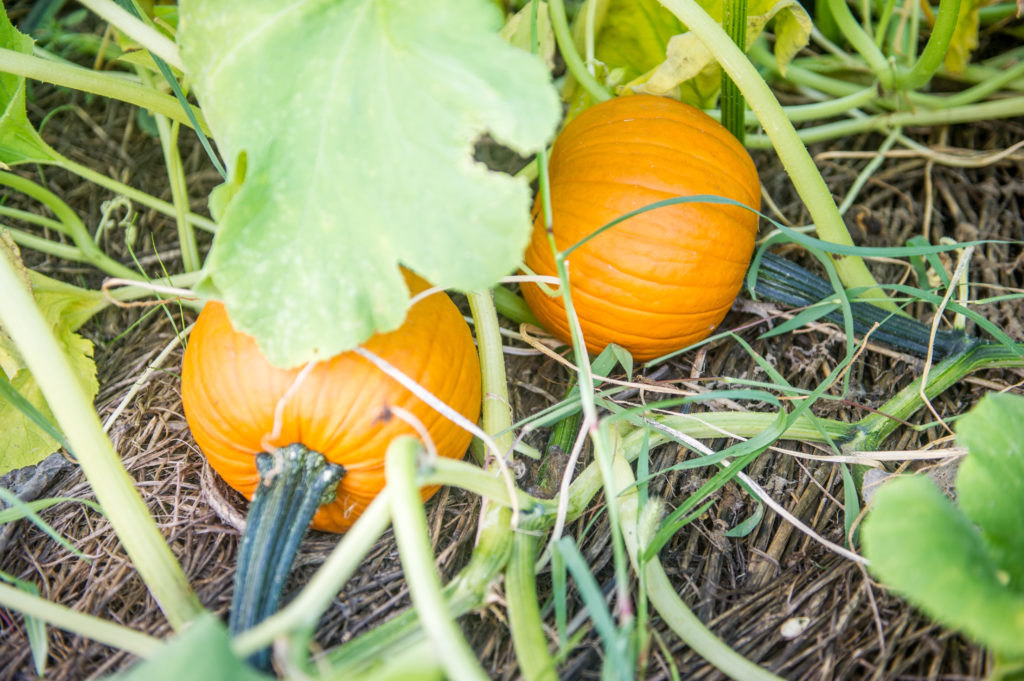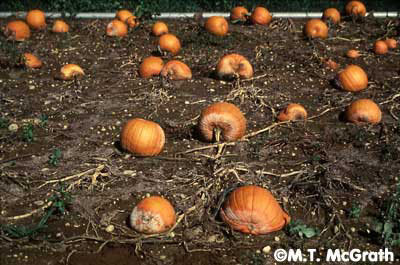Main Content

Greater incidence of Phytophthora fruit rot as a result of this year’s extreme rain events was pointed out in a recent publication of the weekly Vegetable IPM update found on the Plant and Pest Advisory. The minimum 3-4-year crop rotation schedule recommended to reduce incidence of Phytophthora and other soil-borne diseases of pumpkin like fusarium, plectosporium blight, and white mold is not always possible on New Jersey farms. Here in the Garden State, vegetable growers tend not to have sufficient acreage to rotate completely out of pumpkin and other susceptible hosts for this length of time. Proximity of pick-your-own fields to parking or established hay ride routes must also be considered.
If you are dealing with an infestation of Phytophthora fruit rot or one of these other soil-borne diseases, you must work proactively this year to limit future infestations. There is no remedy for infested fruit so care must be taken to remove diseased fruit from the field. If harvesting for wholesale, be aware that fruit may be infested without showing signs yet. To prevent post-harvest rot in bins, avoid harvesting fruit both in and near areas showing obvious signs of Phytophthora infestation.
Tillage is another important tool for disease management, and should be implemented post-season to encourage degradation of plant residues. Any crop debris that remains in the field can provide an overwintering site for pathogens, so infested fruit should be entirely removed from the field and tillage should be used to incorporate remaining plant material. Be sure to till infested fields last and clean tillage equipment after use to prevent spread of pathogens from field to field.
Care must be taken to maintain desirable soil conditions which aid in disease suppression. The ideal soil pH for pumpkin production is between 6.0 and 6.8, at which point soil nutrient availability is optimized. Soils in our area slowly acidify over time and we recommend soil testing at least every 3 years to monitor changes in soil pH and soil fertility needs. For information on soil sample collection and submission to the Rutgers Soil Testing Lab visit https://njaes.rutgers.edu/soil-testing-lab/.

While tillage is a valuable tool for disease management and weed suppression, repeated tillage degrades soil structure. Over time, this can lead to soil compaction and reduced water infiltration – both of which impede soil drainage and promote disease incidence. Consider planting a fall cover crop in preparation for next year’s pumpkins. Cereal rye and other cereal grains are a good choice because they can tolerate late October and even early November planting dates in most years. In addition to building soil organic matter content to counteract the effects of tillage, pumpkins can be planted directly into the stubble or rolled mulch of overwintering cover crops. The cover crop residue suppresses weed seed germination while serving as a barrier between pumpkin or squash fruit and the bare soil – further preventing disease incidence. Choose cereal rye for the later planting dates (first week of November at the latest) and seed at 60-100 pounds per acre to achieve the necessary groundcover for next year’s soil coverage and weed suppression.
If you prefer not to direct seed pumpkin into a cover crop or stubble, consider a cover crop like oats that will winterkill. Opting for a winterkilled cover crop will reduce the amount of biomass you have to deal with in the spring while still working to retain soil nutrients, minimize soil erosion, and increase soil organic matter. To learn more about cover crop options in our area, check out the ‘Cover Crop Explorer’ and ‘Species Selector Tool’ developed by the Northeast Cover Crops Council at https://covercrop.tools/.
Sources
Damicone, John, and Lynn Brandenberger. EPP-7336 Pumpkin and Squash Diseases. Oklahoma State University Extension, October 2019, https://extension.okstate.edu/fact-sheets/pumpkin-and-squash-diseases.html. Accessed 8 Sept. 2021.
Egel, Dan. BP-135-W Pumpkin Disease Management Timeline for Indiana. Purdue Extension, May 2013, https://www.extension.purdue.edu/extmedia/bp/bp-135-w.pdf. Accessed 8 Sept. 2021.
Jasinski, Jim. Disease Management in Pumpkins. The Ohio State University, https://cpb-us-w2.wpmucdn.com/u.osu.edu/dist/f/4395/files/2017/11/Pumpkin-disease-SW-Veg2017-1jmv3zp.pdf. Accessed 8 Sept. 2021.
Wyenandt, Andy, Peter Nitzsche, and Win Cowgill. Bulletin E310: Diagnosing and Managing Important Cucurbit Diseases in the Home Garden. Rutgers NJAES, June 2020, https://njaes.rutgers.edu/E310/. Accessed 13 Sept. 2021.
